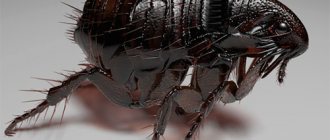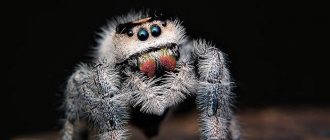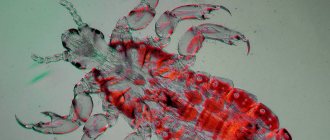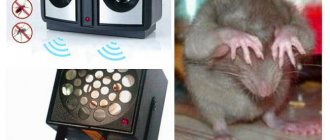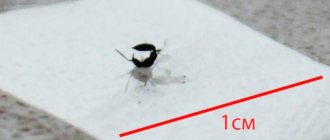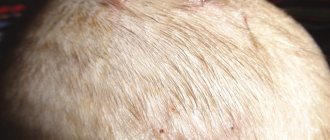Unfortunately, fleas in cats are a common occurrence. Moreover, they can even develop in animals that never leave the apartment. These pests bite pets, cause them pain, and can also infect them with dangerous diseases. Fleas in cats can and should be dealt with. For this, there are both folk remedies and specialized drugs. They have different effectiveness and duration of action, but among all the variety you can choose what will work in a specific case and with a specific cat, taking into account his personal characteristics.
Why and how cats get fleas
A flea is a small blood-sucking insect, the size of which does not exceed 3 mm. She has a flat body and paws with spikes, and the paws are of different lengths. The hind ones are especially long and powerful, they allow fleas to jump a very long distance - half a meter. Considering the size of the flea itself, this is about the same as a jump of two hundred meters for a person.
Fleas are parasites; they live on animals whose blood they feed on.
They easily jump from one victim to another, so it is very easy to pick up fleas while walking. But not all domestic cats go for walks. Many of them never leave the apartment. And even in this case, you can get a parasite. Where do fleas come from in a domestic cat?
- from other animals if they enter the house;
- from owners who can bring insects on their clothes, in a bag of groceries, household items and on shoes;
- from neighbors, from the common corridor and common areas, from where fleas can get there on their own.
Even if you maintain an almost sterile cleanliness in the house, there is no absolute certainty that your cat will not pick up fleas.
Wild animals
A house cat is not going to stalk prey in the wilds of neighboring gardens, but you may be surprised to learn that they may have the opportunity to hunt in your home.
Wild animals, especially rodents, can get inside, especially if you live in a rural area or have a garden, basement or attic. While these critters are unlikely to want to stay within reach of a healthy cat's claws, rats, mice and the like are breeding grounds for fleas. Of course, it's possible, especially if you end up infested, that they could drop flea eggs in the house, which then hatch and get to your cat.
Cats themselves repel rodents, but you can help too by clearing food and waste from counters. Make sure your kitchen trash can has a heavy-duty lid, empty it regularly, and store it outside. Food scraps should be immediately put into a compost heap, if you have one, or thrown away.
If hungry invaders are still a problem, check your home for possible entry points, seal gaps in doors and windows, and install screens on ventilation and plumbing openings. You may find it helpful to consult a pest control professional to advise you on preventive measures.
Why are fleas dangerous?
These pests feed on the blood of animals. They bite through the skin and suck out blood. In this case, substances are injected into the wound, which prevent the blood from clotting quickly and also cause severe irritation. Flea bites are very itchy, the cat is constantly itching, scratching the wounds, which easily become infected. Fleas bite a wide variety of animals, so they are carriers of pathogens of dangerous diseases. Some of them can be fatal or lead to serious consequences.
Cat fleas do not live on humans, but in the absence of a familiar and more suitable victim they can bite people, which is also dangerous.
Cat flea: who is it and where does it come from?
To understand where cats get fleas from, you should learn more about these parasites: their structure, feeding habits, and life cycle. Fleas are a huge order of wingless insects that are blood-sucking exoparasites and parasitize on any animal. They have a rather narrow specialization: there are fleas of rabbits (Spilopsyllus cuniculi), dogs (Ctenocephalus canis), humans (Pulex irritans) and cats (Ctenocephalides felis). These insects also parasitize rats and birds. Outwardly, they are very similar; only a professional entomologist can determine the exact type of insect.
general description
What does a flea look like on a cat? Their body size ranges from 1 to 5 mm, the cat flea reaches approximately 2 mm. Males are smaller than females. The parasite that has sucked blood increases sharply in size—approximately 2 times. The insect's body is flattened laterally (this makes it easy to move between hairs) and covered with numerous spines and bristles. They help the insect to stay between the hairs of fur or feathers.
The oral apparatus of the parasite is of the piercing-sucking type, which includes a special stylet that pierces the skin of the host. They do not have a proboscis. The limbs of the parasite are strong, they give it the ability to move along surfaces at any angle, as well as make long jumps. The abdomen has special tactile hairs that are sensitive to air vibrations.
They are wingless insects - with their lifestyle, wings would only get in the way of the parasite. The shape of the body and the chitinous cover make mechanical damage to the insect very difficult - it cannot be crushed with your fingers. The parasite can only be destroyed by crushing it with a fingernail on a hard surface.
This is interesting! Fleas are one of the best jumpers in the animal kingdom. Having a size of only a few millimeters, they can jump 19 cm in height and 30 cm in length. This is a hundred times the size of their own body. A person, in order to repeat these results, must long jump 160 meters.
Life cycle
Fleas are insects with a full life cycle; they have the stages of adult insect, egg, larvae and pupae. The female lays her eggs anywhere, and after about two weeks a worm-like larva appears, which grows and molts several times. The larvae live in dust and debris, feeding on decaying organic matter and excrement.
Later, the larva pupates and after a while emerges from the pupa as an adult insect. Now she just needs to find her owner.
The insect's lifespan is approximately 2 years. Parasites reproduce very actively; during her life, the female lays up to 2 thousand eggs.
Cat fleas can also spread to rats, and they displace the rat flea.
Eating habits
Each type of parasite prefers its own host. They adapt to a certain skin structure, its temperature, the composition of the host’s blood and other characteristics. They can feed on the blood of other animals, but they do not do this very willingly.
Although, it should be noted that in this regard the cat flea is the most picky, as it can easily drink both dog and human blood. She is the champion in the number of bites to people.
Typically, these insects do not live permanently on their host. Rather, it serves as their dining room. They attack him from time to time, drink his blood and leave again. They live near their owner. There are some types of fleas that live permanently on their host; these are parasites of nomadic animals.
They feed daily, but can easily endure several months of fasting, after which they pounce on food with particular greed.
This is interesting! Fleas have changed little over the past 50 million years. The fossil insects that scientists studied are almost no different from modern ones. Evolution, apparently, considered that it had already created a masterpiece, which did not make sense to change.
Diseases
Fleas are carriers of serious diseases in humans and domestic animals. Rat pests are especially dangerous. They carry plague, typhus and other serious diseases. In the Middle Ages, entire cities died out from plague epidemics transmitted by rats.
Fortunately, the cat flea does not carry such dangerous diseases, but other types of these insects can live on your pet.
Symptoms of fleas in a cat
It is quite simple to understand that a cat is overcome by fleas. You need to keep an eye on your pet. The following signs indicate the presence of parasites:
- the animal is constantly itching;
- there are small wounds on the skin with dried crusts;
- small black dots can be found in the fur - these are insect excrement;
- You can also see the fleas themselves - they move along the coat, undercoat;
- the animal becomes nervous, restless, sleeps poorly, often wakes up to scratch itself, and its appetite worsens.
Symptoms of a dog being infected with fleas
How can you determine that your pet is infected with fleas, because it is not so easy to see them on the animal’s body, especially if the dog is dark in color.
You can suspect something is wrong based on the following signs:
- The primary sign is that the dog is constantly itching, all over, here and there. The scratch is very characteristic: fast and furious.
- The animal sleeps poorly and nervously wanders around the apartment in search of relief from the unbearable itching. The dog becomes irritable and restless.
- A characteristic sign of a dog being infected with fleas: the pet begins to sharply bite into the skin, clattering its teeth, trying to catch the irritant.
- In advanced cases, the dog may develop an allergy to fleas. The eyes begin to water, the skin becomes covered with a rash, small blisters and pustules that burst and form ulcers and scabs. The animal can scratch such formations until there are bloody wounds and bald patches.
- If treatment is not started in time, fleas will lay eggs in the animal’s fur. They can be easily seen. But in this case, dogs with dark colors, so to speak, find themselves in a more advantageous situation. The fact is that flea eggs are light grains, in appearance somewhat reminiscent of grains of rice, only much smaller. The size of the eggs does not exceed one millimeter.
- If you run your hand over a dog’s fur, then in addition to fleas, larvae and eggs quickly hiding and escaping in the undercoat, you can see dark grains (parasite feces) on the animal’s fur.
- If it is difficult for the owner of a four-legged dog to determine whether his pet has fleas, then the best way to identify insects is to run a bath of water and bathe the dog. Upon contact with water, fleas will begin to move onto the animal’s head or jump into the water.
Flea removal methods
Insecticides are used to kill insects. These are industrially produced preparations, they are offered in different forms: sprays, drops on the withers, shampoos, collars. They are quite effective, but can also be toxic to the animals themselves. That is why they should not be used to remove fleas from pregnant cats, weakened kittens, and older animals. These drugs can also cause an acute allergic reaction.
Less toxic, but also not as effective, are folk remedies for flea control. In addition, some of these methods are quite complex to implement and require repeated or regular use.
Features and signs of fleas in a cat
Unfortunately, not only fleas, but also other types of insects (ear and ixodid mites, lice, lice, coccidia) can pester cats. Therefore, it is important to distinguish these particular parasites and immediately begin removing them.
Fleas are brown, blood-sucking insects, approximately 2mm in length, that can be found in an animal's fur. A characteristic feature of fleas is their ability to move very quickly; the jumps of these parasites over long distances are difficult to notice with the naked eye. Unlike lice eaters, fleas attach themselves to the skin of animals, and not to the fur itself. In addition, lice eaters do not have the ability to jump. You can distinguish a flea from a tick by the number of legs; ticks have 8, while a flea has only 6. The photo shows a tick, a louse, a bedbug and a flea; their differences are visible on it.
You can recognize the presence of fleas in domestic cats by a number of signs:
- restless behavior;
- frequent itching and irritation of the skin;
- the appearance of worms;
- an allergic reaction is possible;
- the presence of small red dots at the bite sites;
- decreased appetite.
Pharmaceutical preparations for fleas
These include funds in different forms:
- shampoos;
- sprays;
- drops;
- pills.
The choice of product depends on the degree of flea damage, the condition of the animal and the ability to use one or another drug. It's no secret that washing cats is a very difficult task.
Shampoos
The most popular flea remedy. It is relatively safe, but at the same time effective. Shampoo helps get rid of fleas if their number has not reached a critical level, when the entire undercoat is literally swarming with insects. At the initial stage, one wash with a specialized shampoo will be enough.
You can add Ectometrin from Medilis to your regular animal shampoo at the rate of 2 ml per 200 ml of detergent.
Important: you need to use an anti-flea shampoo designed specifically for cats. It is also very important to rinse the wool thoroughly after washing, without leaving even the slightest trace of shampoo on it.
There are flea shampoos that can be used on small kittens.
Sprays
A more convenient drug to use. It can be sprayed outdoors or in a ventilated area. At high concentrations, aerosols are toxic to both the pet and the owner. Flea sprays are only suitable for short-haired cats. With long hair, the drug simply will not achieve its goal.
Alternatively, you can use Ectometrin emulsion from Medilis. It is diluted according to the instructions, applied to the wool with a swab so that the product is absorbed into the skin, and not just into the wool.
Important: when processing, you need to put a cervical collar on the cat so that he does not lick the drug from the fur. It is also necessary to protect your eyes and nose from contact with the insecticide.
Drops
Another popular remedy. It is suitable for treating cats with fur of any length and thickness. Drops are applied to the animal's skin at the withers. Not even the most flexible animal can lick them off the withers. But if there are several animals in the house, they can lick each other, so when processing it is important to separate them to prevent poisoning.
Important: choose drops from trusted manufacturers. These can be “Stronghold”, “Broadline spot on”, “Advocate”, “Advantage”, “Frontline combo”, “Vectra”, “Rolf”. Make sure the product is intended for flea control in cats. It is necessary to strictly follow the instructions and not exceed the prescribed concentration. It is also important for the owner to take care and not allow the product to get on his hands.
Tablets and solutions for injections
This method of control is less known, but there are flea medications for oral administration. Getting into the blood of a pet, they do not harm it, but become destructive for fleas that drink this blood. Flea tablets are usually given to the cat before deworming.
Feeding a cat a pill is quite a difficult task. Therefore, solutions for injection have been developed. The injection must be given by a veterinarian in a clinic setting. It is important to take the appropriate drug and calculate its dose.
Details
Routes of infection
But where does a domestic cat get fleas? A cat may never be in contact with its appearance, but it also has a considerable risk of picking up an unpleasant roommate. It is connected with the fact that fleas of all varieties are very prolific and even getting one adult flea or nit on the fur threatens the development of an entire colony.
The most common route of infection is among those cats that walk on the balcony or spend time on the windowsills of the first and second floors. Parasites get there either from the basement directly, or from yard animals. Fleas are jumping, so a low base can provoke them to reach the second floor naturally. On the upper floors, fleas can be transmitted to a cat by a bird flying into a window.
The second most popular way is fleas on clothes and shoes brought by the owner from the street or from guests. You can catch them not only through contact with a sick animal, but also by passing through an entrance where fed street cats wipe themselves.
Cats that like to run out onto the playground are also at high risk. Fleas can be picked up there in the same way - the parasite jumped from the basement or was carried on shoes from the street.
Oddly enough, you can also bring fleas from a veterinary clinic in a cat’s fur coat. This is due to the fact that both domestic and street animals are brought to doctors, who sow fleas and pupae around them very generously.
At exhibitions, there is also a chance of picking up fleas, because someone may simply not know that an animal has picked up parasites somewhere and come to a public place with an initial infestation.
Therefore, it is impossible to say that a cat is completely domestic; one way or another there is contact with the outside world, and fleas will not take long to appear there.
Methods of combating infection
Treating fleas on a domestic cat is a fairly simple process, but you need to be patient.
After you have discovered fleas in your cat's fur, the first thing you need to do is arrange a bath day with a special shampoo. Leopard, insectin, phytoelite - you will find these products even in the smallest pet pharmacy. Anti-flea shampoos are suitable for all coat types and do not cause allergies. The shampoo saves from adult fleas in a domestic cat, partially from egg laying, but it definitely won’t help the first time, especially with a severe infestation.
Comfortis, Braveco, Sentinel Flavor Tabs are tablets that can speed up the death of parasites. It is recommended for severe damage, when the cat’s body begins to secrete substances harmful to fleas along with skin secretions. They are problematic to feed, but show good results.
Fipronil, ivermectin, permethrin - drops on the withers, which are good after using shampoo. Hatched insects will die immediately, without having time to lay new clutches. Repeated washing will help in combination with droplets. But all drops have contraindications, be careful with the dosage.
IMPORTANT: use sprays to treat the cat’s bed and favorite resting places. You can wash the cat as much as you like, but if the fleas in the apartment are not exterminated, re-infection will occur over and over again.
After the initial treatment of the cat, perform a general cleaning with special equipment. Soft sofas and carpets require special treatment, since fleas love to wait on such surfaces for a new owner.
IMPORTANT: if the infection was severe, then it is better to destroy the cat’s bed or boil it.
Using flea collars
A very popular remedy among cat owners. The collar is impregnated with special preparations that repel fleas. It is effective, but its range of action is very limited, that is, it protects the front of the cat, while the back remains unprotected. It is important that the collar is intended specifically for cats, otherwise the dosage may be too high and the drug may be toxic. Collars need to be changed promptly, as they are valid for no more than a month. You also need to consider that collars can irritate the skin and cause allergies.
A type of collar is a flea keychain for a cat. It is hung on a collar or placed in a house or on a bed where the cat is used to lying. The key fob is battery operated. It emits ultrasound, which is not dangerous to the cat, but repels fleas within a meter radius.
Danger of fleas
I know that not all owners are wary of fleas, although in fact it is a really huge problem that can even lead to death. If your pet suffers from a chronic disease (worse if it is still hidden) or has low immunity, parasites can worsen the body’s condition. My cat picked up these insects, but they were hard to see under her thick fur. Chronic disease combined with parasites led to the death of the animal.
Lack of treatment leads to dangerous consequences. For example, a cat may develop anemia due to the abundance of blood-sucking parasites on the body, which, due to their quantity, consume a large volume of blood, and the cat’s body does not have time to replenish it. Therefore, if you find a cat on the street and see a huge number of fleas, be sure to contact a veterinary clinic and treat the animal!
Fleas often cause allergies due to the injection of a special substance into the body. Against this background, the development of allergic dermatitis is possible, which is manifested by the appearance of bursting blisters. They are difficult to heal and cause itching.
Insects can carry other parasites and infect your cat with worms.
And of course, it is worth understanding that any bite is a micro-wound through which an infection can enter the body.
Traditional methods of fighting fleas
Fleas have been pestering pets for a very long time. During this time, many methods of combating them have emerged. Most are safe for pets, but many are not very effective.
There are also more toxic options. For example, remembering that people used to get rid of lice with kerosene, someone is trying to use it against fleas. This should not be done under any circumstances. This leads to serious poisoning and death of the animal.
Most often, cats are bathed in a decoction of wormwood and rosemary, and soap with wormwood is used for washing. If there are a large number of fleas, these remedies do not help. After using all types of soap, it is important to thoroughly rinse the fur so that your pet does not ingest harmful substances.
Other folk remedies for fleas in cats:
- Bathing in salt water (100 grams of salt per liter). The cat should be placed in a bowl of salt water so that the entire head is on the surface. You need to keep the animal in a salt bath for 10 - 15 minutes, then rinse the fur thoroughly using regular baby soap, dry it and comb it thoroughly to remove dead fleas. The procedure is repeated after 5 – 7 days. Several treatments may be needed. Salt baths can be used to remove parasites from kittens and pregnant cats.
- Treatment with tar soap. You can take liquid soap or lather a solid bar. You should get a thick foam, which is applied to the cat’s entire body and left for 15 minutes, after which the cat can be wrapped in a thick towel. To prevent parasites from scattering around the apartment after removing the towel, it is better to keep the cat in the bath. After the required exposure time, the cat is thoroughly washed, dried and combed. The procedure is repeated a week later.
- Essential oils. They don't kill parasites, but they repel them. Oils with strong odors also do not destroy the eggs that fleas have laid in the fur. The oil is used only in diluted form: 3 – 4 drops are diluted in a glass of water. This water is applied to the cat's fur, trying to saturate the entire coat of the animal down to the skin. You can use oils of pine, cedar, eucalyptus, wormwood, lavender, and anise. You can use essential oils with caution to remove fleas from kittens and pregnant cats, but you need to make sure that the animal does not have individual intolerances or allergies. At the same time as treating with oils, you need to carefully comb out the cat's fur. This way you can reduce the number of fleas by simply removing them mechanically, as well as remove eggs and larvae.
- Wormwood decoction. This plant has a very pungent odor that parasites do not like. Prepare the tincture by pouring five tablespoons of dry leaves into a liter of water and bringing to a boil, simmering over low heat for 20 minutes. The broth is cooled, filtered and the wool is generously moistened with it, then the animal is wrapped in a terry towel for 15 - 20 minutes. Then the wool is washed, dried and combed. This product also does not destroy larvae and eggs; they need to be combed out. A decoction of geranium leaves also works. Both remedies must be used several times.
- Homemade flea shampoo. Take liquid tar soap or diluted in water, add egg yolk, finely chopped onion and wormwood decoction to it. You should get a paste that is applied to the moistened coat, rubbing it into the skin. Then the cat is wrapped in a towel for 20 minutes. After exposure, the wool covering is thoroughly washed and dried, then also thoroughly combed.
How to check a cat for fleas?
After carefully examining the animal, it is easy to verify the presence or absence of fleas. To do this, you need to use a wide-toothed comb, and, spreading the fur, carefully examine each area of the skin. The presence of cat parasites will be indicated by red spots, irritated skin of the pet, as well as traces of parasite activity - small flesh-colored eggs, dark dirt and pieces of dried blood. If the examination of the pet does not yield results, but its behavior is restless, then you can do it differently: using a slicker brush, comb the animal and place the resulting contents on a sheet of white paper. The detection of small black dots indicates the presence of flea excrement.
Once you have confirmed the presence of blood-sucking parasites, you must immediately begin to fight them, as they serve as carriers of various dangerous infections and can cause allergies in people.
What else needs to be done at home
If not only the animal is infected with fleas, but also the apartment in which it lives, the entire home must be treated. Eggs and insects may be present in the cat's bedding or house, on clothes and shoes, and household items. Therefore, along with treating the cat, it is necessary to disinfest the apartment.
Before processing the apartment, a thorough cleaning of the room is necessary. Wash at a temperature of 60 degrees all textiles that can be washed: curtains, bedspreads, blankets, rugs, pillows. It is also advisable to iron all textiles or fry them in the sun. If possible, it is better to treat everything with a steam cleaner. You need to wash all your shoes, wash or dry-clean your outerwear, hats, and scarves.
Then they are treated with an insecticide. It can be in the form of a spray or solution for spraying and wiping surfaces. It is sprayed throughout the room, especially attention should be paid to baseboards, floors, and furniture standing on the floor. It is also advisable to treat upholstered furniture. To treat premises against fleas, you can use insectoacaricides from Medilis: Malathion, Permifen, Super, Cyper, Neo. They destroy not only fleas, but also other parasites unwanted by humans. However, it is necessary to strictly follow the instructions when preparing working solutions and using them.
After the exposure time specified in the instructions has passed, furniture, carpets, floors and other surfaces are vacuumed to remove dead insects. After this, you can wash the floors and other surfaces with water with the addition of strong-smelling essential oils, such as pine or wormwood.
All processing is carried out observing safety precautions. There should be no animals or people in the room. After applying the product, you need to leave the apartment for several hours, and then thoroughly ventilate the entire apartment.
Prevention
After you have treated your pet, you need to disinfect the room. Remember that fleas live in warm places, in crevices between the floor and the wall, and in high piles. Therefore, purchase wormwood extract or bleach at the pharmacy and treat the entire room, window sills (if they are wooden), furniture where there are cracks. Give a vacuum cleaner a good run through cracks and carpet piles, as well as upholstered furniture, to remove etched fleas and their eggs. An effective method would be to clean the room with dichlorvos.
The pet's bedding and clothing should be boiled or washed in hot water, and then ironed with plenty of steam. Put a collar on your pet or ask your veterinarian to prescribe a medication in drops that is used to prevent fleas.
How to remove fleas from a pregnant cat
Pregnant and lactating cats also suffer from fleas. They must be removed, as infection with parasites affects the development of kittens. It is important that the products are non-toxic. It is better if the drug is selected by a veterinarian after assessing the animal’s condition. For treatment, sprays or drops are used on the withers. The preparations must contain an indication of the possibility of use on pregnant and lactating animals.
Shampoos, drops on the withers and sprays are also used to treat kittens. There are products that can be used within a couple of days after the kitten is born.
No scratching - no fleas?
Most owners of pets think that if their pet is not bothered by itching, then there are no insects. But the animal may begin to itch only when the parasites are gnawing on it. And while only a few individuals are running on the surface of its skin (which does not last long), it may not show external disturbance. Therefore, you should periodically examine your pet’s fur in order to detect your pet’s enemy at the initial stage of infection. It also happens the other way around, when the cat itches but there are no fleas. A veterinarian will help you find the cause of the itching (allergies, stress or other diseases cannot be ruled out).
So, we found out that the problem of parasites is relevant for all pets at any time of the year. The main thing is to know how to remove fleas from a cat and disinfest the entire living space.
Preventing flea infestation
There is no absolute protection against fleas. But you can reduce the likelihood of infection. To do this, you need to take the following measures:
- for prevention, apply drops to the withers every two months or six months, as indicated in the instructions;
- do not let the cat go outside;
- regularly take the animal to the veterinarian, who can detect parasites in time.
If it is known that there are fleas in the house, which is especially true in older buildings, it is worth using pest control products to treat the apartment from time to time.
If a cat walks outside, it makes sense to vaccinate it. Once a year, a vaccination is given that protects the pet from pests. Vaccination is done only in a veterinary office.
Moving to a new home
Just because people and pets have moved does not mean the fleas have moved in. Flea eggs can take up to a year to develop into larvae, pupae and adults, and flea pupae can lie dormant for months waiting for their next host.
Central heating keeps our homes warm and cozy all year round, providing the perfect temperature for fleas to live in summer or winter.
When moving to a new home, plan for the worst and hope for the best. Clean your new home as if it were infested. You can do it yourself or just call a professional.
By now you've probably realized that fleas are cunning creatures that can sneak into our homes in a variety of surprising ways, from hitchhiking on unwanted rodents and visitors to leaving sleeping eggs in upholstered furniture.
Moreover, don't forget that indoor cats are never 100% indoors—trips to vets, groomers, and catteries are great opportunities to collect fleas! Fleas can cause a variety of health problems and can be difficult to get rid of, so no matter how much time your cat spends indoors, it's important to provide protection.
How can you tell if your cat is infected?
Having settled on the body of the owner, at first the fleas do not make themselves felt. Moreover, given their microscopic size, it is quite difficult to determine that a cat is infected with ectoparasites. Especially if your pet has long fluffy fur.
As the number of parasitic colonies increases, owners of furry purrs should be alert to the following symptoms:
- severe itching;
- the appearance of scratches, allergic rashes, and ulcers on the body;
- pallor of mucous membranes;
- decreased physical activity, depressed state;
- deterioration of the coat condition.
Due to severe itching, cats become restless and constantly lick and gnaw at itchy areas with their teeth. The fur becomes disheveled, dull, and loses its natural shine.
Flea excrement
With a severe flea infestation, hairless areas appear on the body of animals in the croup area, on the sides, and neck. If you move your pet's fur away, you will notice many small black dots, which are flea excrement. At the base of the roots of the hairs, upon closer examination, dark brown grains are visible - half-digested fragments of blood.
Favorite places for fleas to localize on a cat’s body: croup (at the base of the tail), tummy, muzzle, especially near the ears, upper neck, withers. It should be noted that nasty ectoparasites can drive your beloved cat to neurosis. Therefore, owners must urgently take appropriate measures to make life easier for their furry pet.
The cat is itching

